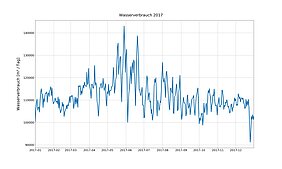The basis for the design of drinking water supply systems is a detailed examination of the development of peak consumption and peak factors over a longer period of time. The DVGW research project "Peak Consumption" has dealt with the processing of data series on peak consumption of water supply companies in order to review trends of the past years, to examine influencing factors and to derive recommendations for action for the DVGW regulations.
Drinking water supply systems are designed on the basis of corresponding characteristic values in order to ensure a continuous supply of drinking water of high quality, sufficient quantity and sufficient pressure. In addition, economic aspects must be taken into account in the design. The peak consumption or the peak factors are relevant for the dimensioning of systems (DVGW W 410). For the research project, an investigation was carried out with regard to the development of the hourly and daily peak factor in the past years and a review of the approaches for calculating the hourly and daily peak factor in Code of Practice DVGW W 410. In summary, it can be stated that the function curves contained in Code of Practice W 410 for determining the daily and hourly peak factor based on the number of inhabitants tend to lead to an overestimation of peak consumption in smaller supply areas. Overestimation creates corresponding resilience within the system, which contributes to supply security from the point of view of changing boundary conditions. The values for supply areas with more than 100,000 p.e. correlate with the function curves. It can be deduced from the project results that there is no immediate need to adapt DVGW Code of Practice W 410, as the formulas described in the Code of Practice only represent a dimensioning aid. For the development of a calculation approach that takes into account other influencing parameters, such as climate and infrastructure, an improvement of the data basis for infrastructure data is necessary. Such data was not available in sufficient density for the investigations in the research project. . A forward-looking approach is the use of individual data-driven models for each supply area. This allows peak demand values to be calculated with high accuracy and the individual influencing factors to be evaluated. The basic principles for such models were developed within the framework of the project.
Publications:
Martin, T.; Korth, A.: Stand und Perspektiven zum Einsatz von Algorithmen und Modellen zur Kurzzeitprognose für den Wasserbedarf. Abschlussbericht DVGW-Projekt W 201715 (2020)
Martin, T.; Wagner, M.; Korth, A.: Untersuchungen zur Entwicklung von Spitzenverbrauch und Spitzenfaktoren. DVGW energie | wasser-praxis 04/2021, 60-63 (2021)

![[Translate to English:] Prüfstelle-Produktprüfung_Teststand Test centre and product testing](/fileadmin/_processed_/0/9/csm_TZW-Karlsruhe_Pruefung_Geraete-Teststand_377188946c.jpg)

























